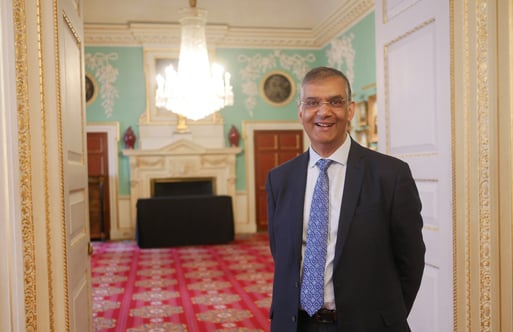Sir Desmond has implemented computer systems for Sperry Univac; ran computerised switching systems for Plessey; introduced Littlewoods, the football pools and various retail companies to computerisation; chaired the Merseyside Development Corporation and delivered Faraday lectures for the Institute of Electrical and Electronic Engineers… quite an achievement for an evacuee who didn’t start learning until he was ten!
Pitcher’s early life
Sir Desmond Pitcher was born in Liverpool in 1935. His father, a film production manager, left shortly after he was born. He was then raised by his mother until the outbreak of world war II, when she was co-opted and Desmond moved in with his grandmother near to Liverpool docks.
He says: ‘My first impression of life was one of chaos and concern. For instance, there were very few men around: you would see women crying on the street in a distressed situation due to losing a son or husband. One week, a week I shall never forget, was in May 1941. It was estimated 59,600 bombs were dropped on Liverpool, completely destroying Liverpool One and 1,000 people died on the streets.’
This almost unimaginable devastation was the result of Liverpool docks being the only English port open with shipping access. The Luftwaffe would fly from France to the lights of Dublin and then over Liverpool in an attempt to stop the flow of goods and troops coming from Commonwealth countries.
A haphazard education
As a result of the disruption caused by WWII, Desmond says that he never really had any proper schooling until he was nearly eleven. He adds: ‘If I summarise one aspect of my own character; I’ve never been frightened of anything and I really put that down to those early years.’
In 1942, Desmond was evacuated to Llangollen, where school lessons were given in Welsh. At the age of ten, he returned to Liverpool to continue, or really start, his real education. He explains: ‘The implication of that (attending a Welsh speaking school) of course, was that I never got a chance to go to a grammar school or any other kind of education like that. But, I did win a scholarship to go to Liverpool Technical College and that was a big breakthrough for me.’
He went on to study at the Liverpool College of Law, Liverpool Commercial College and at the Law Institute. Desmond adds: ‘So I had a whole batch of examinations, but nothing to show for them. But that was put right by Manchester University, because I also studied at Manchester, where they made me, in later years, an Honorary Professor for 20 years or so.’
Starting his career at AV Roe
One of Desmond’s earliest and most enduring interests was engineering, which came out of his love of steam trains as a child. After college, he became an electrical systems engineer at AV Roe (now Avro) - a plane maker based in Manchester - where he worked on the electrical systems for the Vulcan bomber.
The Vulcan, due to its load requirements, could not fly with conventional DC electricity and required higher volume AC. Desmond joined a team of four engineers with the support of about 20 skilled staff to solve the logistical problems of the aircraft. The outcome of this is that all large aircraft, except Boeing, have used the AC system ever since.
Moving on to Sperry Univac
In 1961, Desmond moved to Sperry Univac as a systems engineer, having responded to an advert in The Times, offering a scholarship to study computer development in Switzerland.
Univac had absorbed the Eckert-Mauchly computer company, which created the ENIAC - the Electronic Numerical Integrator and Computer - and the first electronic general-purpose digital computer in the USA. Looking at the competitors at that time, Desmond says: ‘IBM dominated the commercial market. They took their business out of a massive commercial base and brought it into computers. The concept of Sperry Rand was to achieve the same thing, except that Sperry Rand had a different market offering with high-cost large-scale systems for banking, hospital, manufacturing, space programme, government and various other sectors.
Sperry was appointed to project manage the supply of all the computers in their control centre as they raced to get the first man on the moon. It was at Sperry that Desmond noticed the difference between UK and US attitudes to challenges and progress.
He continues: ‘The difference between Britain and America is, [in Britain] we argue, we talk about the problems all the time. Working in the American industry, everybody says, “What can we do?” Looking to the future and particularly to the market opportunities.’ Desmond also said he learned to ‘never get gloomy about the past. Look for examples where it’s gone wrong and put them right, but don’t let it dominate your conversation.’
In his time at Sperry, Desmond implanted the 1100 series with a number of customers including the RAF, Treasury, Royal Navy, Abbey National, Shell, BP, among others. He says: ‘The first company we took was Coutts Bank, oddly enough, because they wanted online printed statements. Nobody else could give them that.’ This new range of computers offered customers a real-time interactive communicating system, which was years ahead of what was on offer from competitors such as ICL.
Desmond was promoted by Paul Lyet, Sperry’s Chairman, from Managing Director to Vice President International. However, in order to progress further up the management chain, Desmond was aware that he would need to become an American, so at this point, he elected to return home to the UK.
In 1976, he became managing director of the bus and truck division of Leyland, then two years later, joined Plessey. Here, as MD, he tackled numerous union issues to establish a manufacturing site to make System X for BT, in Liverpool. He continues: ‘I brought the technology people in from Sperry to run the research side and they got System X up and running, which was exactly what BT needed to digitise their network and make it a voice and communications network.’
Headhunted for Littlewoods
In 1983, Desmond was headhunted to be group chief executive of Littlewoods, one of Liverpool’s leading blue-chip companies, owned by the Moores family. The organisation consisted of six businesses, including Littlewoods Pools, Littlewoods retail, mail order, property, finance and transport. Desmond realised that, to remain competitive, it needed significant modernisation, introducing a programme of new computer systems and management training. In 1992, Desmond became non-executive vice-chairman of Littlewoods.
Merseyside Development Corporation
In 1991, Desmond was made chairman of the Merseyside Development Corporation. This was part of a regeneration initiative put in place by the conservative government in 1981, in response to deprivation that caused city riots in Brixton, Birmingham, Leeds, Manchester and Toxteth in Liverpool from April to July of that year.
Desmond talks about the progress made by the corporation: ‘I’m so proud of it. When I went there in ’83, Toxteth was dominating the city. I mean [at the time] it was a nightmare. And when you go back now and see the regeneration vision being realised, I feel so proud.’
The development work included the building of Liverpool One (L1), a shopping centre that retains the atmosphere of old Liverpool, plus the regeneration of the Albert Docks. Having rejected the use of European money to fund the project, the corporation instead took the Liverpool Philharmonic Orchestra on a four-year tour of the USA, to raise funds for the project. A further £1bn was provided by the Duke of Westminster, plus money loaned from the Allied Irish Bank all helped to foot the bill. The regeneration has seen 90,000 people move to Liverpool in recent years.
The 1974-5 Faraday Lectures
While working at Sperry Univac in the mid-70s, Desmond was invited to give the Faraday lectures for the Institute of Electrical Engineers. He used the opportunity to make a number of predictions - one of which was that the computer, telephone and TV would connect together and develop information technology into ‘teledata’.
Based on his product planning experience at Sperry, he explains: ‘We always worked towards convergence. Our communications capability was far in excess of anybody else, particularly in high volume, which meant switching large quantities of data. We, of course, were aware of micro processing taking place; indeed, we had our own micro processing company.
'So, you could see the potential of this. It was enormous early on; to me, it was obvious that if you could collect all this information together, you would have a fully integrated communications system. Now, the problem in Britain, although we solved it much quicker than any other country, was that everything was analogue.’

















